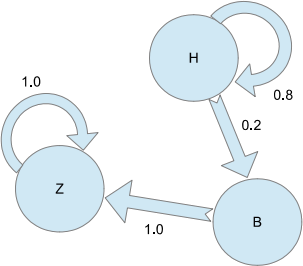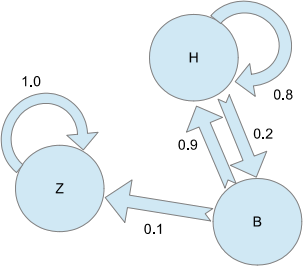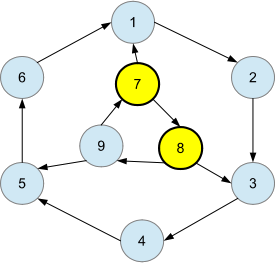Economic Analysis with MATLAB, ECON4101
Hello, dear friend, you can consult us at any time if you have any questions, add WeChat: daixieit
Subject of Economics
Degree of MA(SocSci)/BAcc/BSc/MA
Degree Exam
Economic Analysis with MATLAB, ECON4101
Tuesday, 26 April 2022 9:15-11:15
Exam duration: 2 hours
How to complete this exam:
Answer two questions out of four. Submit the whole work, including the MATLAB code. Youcan
submit MATLAB code as additional files (the best), or you can copy-paste the code into the doc file that you will be submitting. The MATLAB code or the corresponding doc document should have brief comments on what is done by the code.
Materials Supplied:
Question 4 Data: PortfolioChoiceExam.xlsx
Instructions to students:
Read the exam student guidance onMoodle.
For this exam, the required number of questions is 2.
1. Advice on the contents of the exam and technical support
If you have questions about the contents of this paper, or you require technical assistance, please contact our virtual invigilation team at the University of Glasgow Helpdeskhttps://www.gla.ac.uk/helpor on +44 (0)141 330 4800.
An academic member of staff will be available to answer questions about the examination as they would normally at the beginning of the exam. Technical support will be available 24 hours per day. To ensure timely responses and that all students receive the same information, you should not contact academic staff
directly but instead use the Helpdesk.
2. You are about to sit an online assessment
The duration of this exam is 2 hours. Where uploading of files is required you will have 30 minutes to upload your answer files.
3. Time adjustments for students with disabilities
If you have been assessed through the University’s Disability Service as needing time adjustments in exams, your additional time allowance has been configured in
Moodle for each exam.
4. Enlarging the text
If you need to enlarge the text of a PDF document: open Adobe Acrobat; click on the VIEW tab; click on ZOOM and then ZOOM TO; select the desired magnification level.
5. Planning your time
When planning your time, and where required, you should allocate time to download the exam paper and to upload your answers to Moodle at the end of the exam. For students instructed to do so, you should allow time to submit your exam script on Turnitin within the exam period. Please report any technical difficulties experienced as soon as possible viahttps://www.gla.ac.uk/help.
6. Submitting your answers
Acceptable file types for submitting typed documents are: DOC/DOCX; RTF; PDF; XLS/XLSX.
Acceptable file types for submitting high resolution images are: JPG; JPEG; PNG; TIF; PDF.
For code, you may submit zip files and MATLAB .m files.
Please check that you have uploaded the CORRECT FILE, that it is readable and is the version that you want to be marked; if you use a word-processing package other than Word, you are advised to convert and upload as a pdf.
Lastly please ensure you upload files to the correct course Moodle assignment.
Late submissions
This exam has been configured to allow submission of answers for two hours beyond the scheduled exam time. Submissions made during this two-hour period will be treated as ‘late’ and will be graded ‘H’ . Any submissions made beyond this time will be treated as non-submissions.
7. Declaration of Academic Integrity
The following information is very important – your degree may be at risk if you do not adhere to these instructions:
• You must not communicate with any other person about these examination questions during the period in which you can submit your answers
• You must follow any instructions on your examination paper regarding use of resources such as internet sources, books, notes or any other material that would not normally be allowed in examinations on campus.
• The work you submit must be entirely your own effort and must demonstrate your understanding rather than reproduce text from notes, slides, books, or online sources (which is plagiarism)
• You must not submit answers you have discussed with or copied from others, and you must not copy from notes you have prepared with or shared with others. If your answers are similar to those of any other candidate(s) you will both/all be suspected of collusion and referred to Student Conduct
• This declaration incorporates the University’s Declaration of Originality which applies to all academic work (see below).
8. Declaring that the work is your own
Before viewing the exam paper, you must check the box in the Exam Section of the Moodle page to agree to both this declaration and the University’s Declaration of Originality. You will be unable to access the exam paper until you do so.
Instructions.
Answer two questions out of four. Submit the whole work, including the MATLAB code. You can submit MATLAB code as additional files (the best), or you can copy-paste the code into the doc file that you will be submitting. The MATLAB code or the corresponding doc document should have brief comments on what is done by the code.
Question 1.
The elk and wolves (Non-linear systems).
Grey wolves were eliminated in Northern America in the early 1990s. The elk herd in Yel- lowstone National Park expanded rapidly, and ña§ected by climate and seasonal factors ñgrew to some 20000 animals by 1995. This number greatly exceeded the carrying capacity of vegeta- tion on the Park, that was estimated to be 10000. About 30 grey wolves were reintroduced into the Greater Yellowstone Ecosystem in 1995. We want to investigate the population dynamics of wolves and the elk.
We can write down a mathematical model describing the coexistence of elks and wolves in the same habitat. Suppose the elk is the main resource for wolves. Suppose that, in the absence of wolves, the population of elks can be described by the following dynamic equation

where coe¢ cient r is the reproduction rate of the elk, and coe¢ cient K is carrying capacity of vegetation.
(a) Find stationary points for Et (derive an analytical expression),i.e. points where Et = Et+1 for any time period t: Interpret parameter K. Assume K = 10000 and E0 = 20000 and compute how many years are needed to bring the elk herd to be 5% above the carrying capacity.
The elk is consumed by a wolf at the attack rate a when they meet, so the abundance of the elk will decrease and the above equation becomes

where Wt is the number of wolves.
The number of wolves is described by the following equation:
Wt+1 = Wt - μWt + TaEtWt:
Wolves, in the absence of the elk would go extinct with rate μ: However, the number of prays consumed a§ects the number of new wolves born, and parameter T determines the birth rate of wolves.
Assume the following parameters
r = 0:01
a = 0:0001
μ = 0:13
T = 0:15
and the following initial conditions
E0 = 20000;
W0 = 30:
(b) What is the population of the elk and wolves will be in 2025?
(c) Do numerical simulations to check whether, with given parameters and initial conditions, wolves get extinct again.
(d) Find stationary points for Et and Wt (derive analytical expressions and get numerical values),i.e. points where Et = Et+1 and Wt = Wt+1 for any time period t: Find numerical values for stationary E and W and comment on its consistency of these values with findings in (c).
Question 2
Zombie Apocalypse (Markov Chains).
In Zombieland people are neither born nor they die. Suppose there is a full outbreak of a zombie epidemic so that, at any one time, individuals can be in one of three states: healthy (H), bitten (B) or Zombie (Z). The probabilities of moving from one state to another in any period can be described by the following graph:
![]()

(a) Write the transition matrix for this society (ordering the states as Z, B, H such that the row probabilities sum to one.
(b) If the initial state of the people of Zombieland at time zero is given by a vector of probabilities U0 = [0; 0:1; 0:9], calculate the proportion of zombies in the population at the end of 2 periods.
(c) What is the long run distribution between zombies, bitten and healthy?
Suppose that now a team of doctors has found a partial antidote for people bitten: reducing the probability of becoming a zombie, and therefore increasing the probability of a bitten person returning to a healthy state of 0.9. This is illustrated in the following graph:

(d) What is the long run distribution after the cure is discovered? Will the cure reverse the epidemic? Explain your answer.
(e) Finally suppose that the team of doctors then discovers a drug that can return a zombie to Health. If injected, the zombie becomes healthy with a positive probability. Without performing any specific calculation, explain the implications of this for the long run distribution of the people of Zombieland.
Question 3
Flu epidemic (Networks).
The following picture illustrates the standard epidemic SIR model in a networks framework. We distinguish Susceptible, Infected and Recovered individuals. The network is directed, show- ing contacts of individuals and the direction of passing the virus. When contact happens, the probability of passing the virus is one. The illness lasts one period only, after which an individual recovers with probability one. There is no immunity and any individual can be re-infected. We assume that in the initial moment individuals 7 and 8 are infected.

(a) Write down the adjacency matrix for this network.
(b) Using the adjacency matrix and appropriate calculations, find for how many periods at least one individual remains not infected. Identify these individuals. Explain your answer.
(c) Suppos the epidemic has started. If the government has an option to isolate some indi- viduals, who should be isolated first? Explain your reasoning.
Question 4
Portfolio Choice
Please download PortfolioChoiceExam.xlsx file. The file has 10 columns, and 254 rows. The Örst column contains dates, the first row contains names of companies. Columns B contains the data for a S&P500 market index. Columns C-J contain data for 8 individual assets. Each column in B2:K254 contains daily price observations over the span of 253 days. Use these data and answer the following questions. Assume that short-selling is allowed. Assume there are 252 trading days in a year.
(a) Draw the efficient frontier in coordinates standard deviation and expected return, draw position of each individual asset in the same diagram. Comment on your findings.
(b) Introduce a risk free rate, rf = 0:01 per annum. Draw the capital allocation line, compute Sharpe ratio and the standard deviation and return of the market portfolio.
(c) The Capital Asset Pricing Model predicts the relationship we should observe between the risk of an asset and its expected return. It states that the excess return on a risky asset A is related to an excess return on the market portfolio:
E (rA ) - rf = βAM (E (rM ) - rf)
where

and superscript M refers to the market portfolio.
Suppose investor cannot compute the market portfolio weights and uses equally-weighted portfolio W instead. (To build an equally-weighted portfolio you invest 1/8 th of your financial wealth into each of 8 risky assets.) For each risky asset, compute E (rA ) - rf;  and E (rW ) - rf. In coordinates (β; E (r) - rf) plot 10 positions (βAW ; E (rA ) - rf), one for each risky asset in your database. Plot a straight line, passing (0,0) and which has slope E (rW ) - rf: Comment on your Öndings.
and E (rW ) - rf. In coordinates (β; E (r) - rf) plot 10 positions (βAW ; E (rA ) - rf), one for each risky asset in your database. Plot a straight line, passing (0,0) and which has slope E (rW ) - rf: Comment on your Öndings.
(d) Use the S&P500 data as a proxy for the market portfolio. Compute return on the index, and repeat exercise in (c), comment on your findings.
2024-04-15